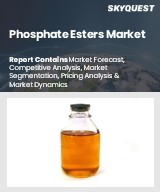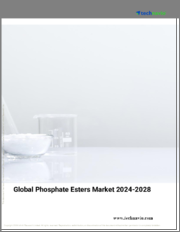
|
시장보고서
상품코드
1618246
인산에스테르 시장 기회와 촉진요인, 산업 동향 분석 및 예측(2024-2032년)Phosphate Esters Market Opportunity, Growth Drivers, Industry Trend Analysis, and Forecast 2024 - 2032 |
||||||
세계 인산에스테르 시장은 2023년 27억 달러로 평가되었고, 2024-2032년간 연평균 6.5%의 성장률을 보일 것으로 예상됩니다. 이러한 성장은 주로 퍼스널케어, 농업, 산업 공정 등 다양한 산업에서 인산에스테르가 다양하게 사용되고 있기 때문입니다. 퍼스널케어 부문에서 인산 에스테르는 유화제 및 계면활성제로서 화장품 및 스킨케어 제품의 효과를 향상시키는 데 필수적입니다. 마찬가지로 농업 부문에서도 이러한 화합물은 효율적인 보조제로 작용하여 농약의 성능을 향상시킵니다. 환경 친화적이고 생분해성 제품을 선호하는 소비자가 증가함에 따라 인산에스테르이 지속 가능한 대안으로 인식되고 있는 것도 시장 성장에 기여하고 있습니다.
다양한 분야에서 혁신과 지속가능성에 대한 관심이 높아지면서 인산에스테르 시장은 상승세를 유지하고 있으며, 향후에도 견조한 수요를 보일 것으로 예상됩니다. 제품 유형별로는 트리아릴 부문이 2032년까지 연평균 6.8%의 연평균 복합 성장률(CAGR)로 24억 달러를 달성할 것으로 예상됩니다. 트리아릴 인산에스테르은 난연제 및 가소제로서 많은 응용 분야에서 우수한 성능을 발휘하기 때문에 인기가 높아지고 있습니다. 트리아릴 인산에스테르은 전자, 자동차, 건축 등 안전성과 내구성이 중시되는 분야에서 사용이 확대되고 있습니다. 가연성 물질에 대한 규제가 강화됨에 따라 제조업체들은 보다 안전한 대체품을 찾고 있으며, 이에 따라 트리아릴 인산에스테르에 대한 수요가 증가하고 있습니다.
또한, 폴리머의 특성을 향상시키는 트리아릴 인산에스테르은 제품 개발에서 기술 혁신을 촉진하여 향후 몇 년동안 이러한 화합물의 광범위한 채택으로 이어지고 있습니다. 용도별로는 난연제 부문이 2032년까지 연평균 6.8%의 연평균 복합 성장률(CAGR)로 12억 달러 규모로 성장할 것으로 예상됩니다. 난연제 시장은 규제 요건 강화와 안전한 선택에 대한 소비자의 요구로 인해 환경 친화적이고 무해한 제품 배합으로 점점 더 전환되고 있습니다. 기존의 할로겐계 난연제는 건강과 환경에 큰 위험을 초래하지 않으면서도 효과적인 난연성을 제공하는 혁신적인 인계 화합물 및 바이오 재료로 대체되고 있습니다. 아시아태평양의 인산에스테르 시장 연평균 성장률은 6.8%로 2032년 20억 달러에 달할 것으로 예상됩니다. 이러한 성장의 원동력은 특히 퍼스널케어 및 농업과 같은 부문에서 급속한 산업화와 도시화에 기인합니다. 소비자들 사이에서 지속가능성에 대한 인식이 높아지면서 제조업체들이 생분해성 인산에스테르를 개발하는 데 박차를 가하고 있습니다. 또한, 친환경 화학물질 사용을 옹호하는 정부 이니셔티브는 시장 내 기회를 더욱 증가시키고 있습니다.
| 시장 범위 | |
|---|---|
| 시작 연도 | 2023년 |
| 예측 연도 | 2024-2032년 |
| 시작 가격 | 27억 달러 |
| 예상 가격 | 48억 달러 |
| CAGR | 6.5% |
목차
제1장 조사 방법과 조사 범위
제2장 주요 요약
제3장 산업 인사이트
- 생태계 분석
- 밸류체인
- 주요 제조업체
- 시장 참여 루트
- 주요 유통업체
- 신규 유통 채널
- 산업 전체 이익률
- 산업에 대한 영향요인
- 성장 촉진요인
- 친환경 제품에 대한 수요 증가
- 지속가능성에 대한 소비자 의식의 고양
- 퍼스널케어나 농업 부문에서의 용도 확대
- 시장이 해결해야 할 과제
- 원료 가격 변동
- 엄격한 규제 프레임워크
- 시장 기회
- 새로운 시장/용도
- 잠재 성장력 분석
- 성장 촉진요인
- 원료 상황
- 제조 동향
- 기술 진화
- 지속가능한 제조
- 그린 프랙티스
- 탈탄소화
- 새로운 재료
- 원료 가격 동향(달러/킬로톤)
- 제조 동향
- 규제와 시장에 대한 영향
- Porter's Five Forces 분석
- PESTEL 분석
제4장 경쟁 구도
- 기업 점유율 분석
- 경쟁 포지셔닝 매트릭스
- 전략 전망 매트릭스
제5장 시장 규모와 예측 : 유형별, 2021-2032년
- 주요 동향
- 새 아릴
- 새 알킬
- 알킬 아릴
- 기타
제6장 시장 규모와 예측 : 용도별, 2021-2032년
- 주요 동향
- 계면활성제
- 내화물
- 윤활유
- 농약
- 가소제
- 유압작동유
- 기타
제7장 시장 규모와 예측 : 지역별, 2021-2032년
- 주요 동향
- 북미
- 미국
- 캐나다
- 유럽
- 독일
- 영국
- 프랑스
- 이탈리아
- 스페인
- 아시아태평양
- 중국
- 인도
- 일본
- 한국
- 호주
- 라틴아메리카
- 브라질
- 멕시코
- 아르헨티나
- 중동 및 아프리카
- 사우디아라비아
- 아랍에미리트(UAE)
- 남아프리카공화국
제8장 기업 개요
- Lanxess AG
- Akzo Nobel N.V.
- Elementis PLC
- Solvay S.A.
- Exxon Mobil Corporation
- Eastman Chemical Company
- Ashland Inc.
- Castrol Ltd.
- Stepan Company
- DowDupont Inc.
- Croda International Plc
- Israel Chemical Company
- BASF SE
- Clariant
The Global Phosphate Esters Market was valued at USD 2.7 billion in 2023 and is expected to grow at a CAGR of 6.5% from 2024 to 2032. This expansion is primarily driven by the versatile applications of phosphate esters across various industries, including personal care, agriculture, and industrial processes. In the personal care sector, phosphate esters are vital as emulsifiers and surfactants, enhancing the effectiveness of cosmetics and skincare products. Similarly, in agriculture, these compounds serve as efficient adjuvants, improving the performance of pesticides. The growing consumer preference for eco-friendly and biodegradable products also contributes to market growth, as phosphate esters are increasingly recognized as sustainable options.
With a strong focus on innovation and sustainability across various sectors, the phosphate esters market is anticipated to maintain its upward trend, with robust demand expected in the years ahead. By product type, the triaryl segment is projected to capture USD 2.4 billion and achieve a CAGR of 6.8% by 2032. The rising popularity of triaryl phosphate esters is attributed to their outstanding performance as flame retardants and plasticizers in numerous applications. Their use expands in sectors where safety and durability are crucial, such as electronics, automotive, and construction. Stricter regulations governing flammable materials drive manufacturers to seek safer alternatives, thus increasing demand for triaryl phosphates.
Moreover, their ability to enhance the properties of polymers is fostering innovation in product development, leading to broader adoption of these compounds in the coming years. In terms of applications, the fire retardants segment is set to grow to USD 1.2 billion, with a CAGR of 6.8% by 2032. The market for fire retardants is increasingly shifting toward the formulation of environmentally friendly and non-toxic products, prompted by growing regulatory requirements and consumer demand for safer options. Traditional halogenated fire retardants are being replaced by innovative phosphorus-based compounds and bio-based materials that deliver effective flame resistance without posing significant health or environmental risks. In the Asia Pacific region, the phosphate esters market is projected to experience a CAGR of 6.8%, reaching USD 2 billion by 2032. This growth is fueled by rapid industrialization and urbanization, particularly in sectors such as personal care and agriculture.Rising awareness about sustainability among consumers encourages manufacturers to create biodegradable phosphate esters. Additionally, government initiatives that advocate for the use of green chemicals further enhance opportunities within the market.
| Market Scope | |
|---|---|
| Start Year | 2023 |
| Forecast Year | 2024-2032 |
| Start Value | $2.7 Billion |
| Forecast Value | $4.8 Billion |
| CAGR | 6.5% |
Table of Contents
Chapter 1 Methodology & Scope
- 1.1 Market scope & definition
- 1.2 Base estimates & calculations
- 1.3 Forecast calculation
- 1.4 Data sources
- 1.4.1 Primary
- 1.4.2 Data mining sources
- 1.4.2.1 Paid sources
- 1.4.2.2 Public sources
Chapter 2 Executive Summary
- 2.1 Industry 360° synopsis
Chapter 3 Industry Insights
- 3.1 Industry ecosystem analysis
- 3.1.1 Value chain
- 3.1.2 Key manufacturers
- 3.1.3 Go to market routes
- 3.1.4 Key distributors
- 3.1.4.1 New distribution channels
- 3.1.5 Profit margins across the industry
- 3.2 Industry impact forces
- 3.2.1 Growth drivers
- 3.2.1.1 Increasing demand for eco-friendly products
- 3.2.1.2 Rising consumer awareness about sustainability
- 3.2.1.3 Expanding applications in personal care and agriculture
- 3.2.2 Market challenges
- 3.2.2.1 Fluctuating raw material prices
- 3.2.2.2 Stringent regulatory frameworks
- 3.2.3 Market opportunities
- 3.2.3.1 New markets/applications
- 3.2.3.2 Growth potential analysis
- 3.2.1 Growth drivers
- 3.3 Raw material landscape
- 3.3.1 Manufacturing trends
- 3.3.1.1 Technology evolution
- 3.3.1.2 Sustainable manufacturing
- 3.3.1.2.1 Green practices
- 3.3.1.2.2 Decarbonization
- 3.3.2 New raw materials
- 3.3.3 Raw material pricing trends (USD/Kilo Tons)
- 3.3.3.1 North America
- 3.3.3.2 Europe
- 3.3.3.3 Asia Pacific
- 3.3.3.4 Latin America
- 3.3.3.5 MEA
- 3.3.1 Manufacturing trends
- 3.4 Regulations & market impact
- 3.5 Porter's analysis
- 3.6 PESTEL analysis
Chapter 4 Competitive Landscape, 2023
- 4.1 Company market share analysis
- 4.2 Competitive positioning matrix
- 4.3 Strategic outlook matrix
Chapter 5 Market Size and Forecast, By Type, 2021-2032 (USD Billion, Kilo Tons)
- 5.1 Key trends
- 5.2 Triaryl
- 5.3 Trialkyl
- 5.4 Alkyl Aryl
- 5.5 Others
Chapter 6 Market Size and Forecast, By Application, 2021-2032 (USD Billion, Kilo Tons)
- 6.1 Key trends
- 6.2 Surfactants
- 6.3 Fire retardants
- 6.4 Lubricants
- 6.5 Agrochemicals
- 6.6 Plasticizers
- 6.7 Hydraulic fluids
- 6.8 Others
Chapter 7 Market Size and Forecast, By Region, 2021-2032 (USD Billion, Kilo Tons)
- 7.1 Key trends
- 7.2 North America
- 7.2.1 U.S.
- 7.2.2 Canada
- 7.3 Europe
- 7.3.1 Germany
- 7.3.2 UK
- 7.3.3 France
- 7.3.4 Italy
- 7.3.5 Spain
- 7.4 Asia Pacific
- 7.4.1 China
- 7.4.2 India
- 7.4.3 Japan
- 7.4.4 South Korea
- 7.4.5 Australia
- 7.5 Latin America
- 7.5.1 Brazil
- 7.5.2 Mexico
- 7.5.3 Argentina
- 7.6 MEA
- 7.6.1 Saudi Arabia
- 7.6.2 UAE
- 7.6.3 South Africa
Chapter 8 Company Profiles
- 8.1 Lanxess AG
- 8.2 Akzo Nobel N.V.
- 8.3 Elementis PLC
- 8.4 Solvay S.A.
- 8.5 Exxon Mobil Corporation
- 8.6 Eastman Chemical Company
- 8.7 Ashland Inc.
- 8.8 Castrol Ltd.
- 8.9 Stepan Company
- 8.10 DowDupont Inc.
- 8.11 Croda International Plc
- 8.12 Israel Chemical Company
- 8.13 BASF SE
- 8.14 Clariant

















